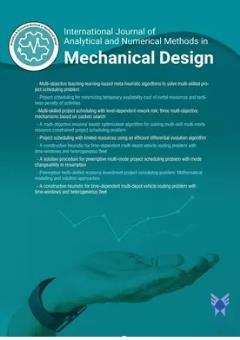Modeling a flat solar panel equipped with PCM for an organic ranking cycle
Subject Areas : Analytical and Numerical Methods in Mechanical Design
Farshid Rashvand
1
![]() ,
Farshad Kowsary
2
,
Ghasem Akbari
3
,
Farshad Kowsary
2
,
Ghasem Akbari
3
1 -
2 -
3 -
Keywords: Thermodynamic analysis, Solar energy, Flat plate collector, Phase change materials, Organic Rankine Cycle, Energy and exergy analysis,
Abstract :
In this study, the performance of phase change materials (PCM) in solar panels and its combination with the organic Rankine cycle, has been investigated. After thermal modelling of the flat plate collector (FPC) and obtaining the amount of collector output energy, different parts of the system are comprehensively examined. Thermodynamic analysis of the solar collector (equipped with PCM) and the organic Rankine cycle is carried out using EES. The parameters affecting the system performance are also investigated, including the amount of solar radiation, the minimum evaporator temperature difference, and the relationship between exergy efficiency and the amount of surface radiative flux. The results reveal that the system performance in the presence of PCM is significantly superior compared to the case without PCM.
[1] L. Evangelisti, R. De Lieto Vollaro, and F. Asdrubali,
"Latest advances on solar thermal collectors: A
comprehensive review," Renewable and Sustainable
Energy Reviews, vol. 114, 2019.
[2] S. A. Kalogirou, Solar energy engineering: processes
and systems. Academic Press, 2013.
[3] K. Pielichowska and K. Pielichowski, "Phase change
materials for thermal energy storage," Progress in
Materials Science, vol. 65, pp. 67-123, 2014.
[4] Tavana A, Javid AE, Houshfar E, Andwari AM,
Ashjaee M, Shoaee S, Maghmoomi A, Marashi F.
Toward renewable and sustainable energies
perspective in Iran. Renewable energy. 2019 Aug
1;139:1194-216
[5] Lorsch, H. G., K. W. Kauffman, and J. C. Denton.
"Thermal energy storage for heating and air
conditioning." Future energy production systems:
Heat and mass transfer processes 1 (1976): 69-81.
[6] B. Zalba, J. M. Marın, L. F. Cabeza, and H. J. A. t. e.
Mehling, "Review on thermal energy storage with
phase change: materials, heat transfer analysis and
applications," vol. 23, no. 3, pp. 251-283, 2003.
[7] N. Shamsundar, "Solar Heat Storage," Solar Energy
Engineering (ASME), 1983.
[8] G. Lane, "Phase change thermal storage materials. the
Handbook of Applied Thermal Design," ed: McGraw-
Hill, 1987.
[9] I. J. B. Marco, China, October, "Seminar on phase
change materials and innovation products—Brianza
Plastica," vol. 20, 2005.
[10] A. Sharma, V. V. Tyagi, C. Chen, D. J. R. Buddhi,
and S. e. reviews, "Review on thermal energy storage
with phase change materials and applications," vol.
13, no. 2, pp. 318-345, 2009.
[11] M. F. J. E. S. Demirbas, Part B: Economics, Planning,
and Policy, "Thermal energy storage and phase
change materials: an overview," vol. 1, no. 1, pp. 85-
95, 2006.
[12] Alvi, Jahan Zeb, et al. "Thermodynamic comparison
and dynamic simulation of direct and indirect solar
organic Rankine cycle systems with PCM storage."
Energy Procedia 129 (2017): 716-723.
[13] B. Zalba, B. Sánchez-valverde, and J. M. Marín, "An
experimental study of thermal energy storage with
phase change materials by design of experiments,"
Journal of Applied Statistics, vol. 32, no. 4, pp. 321-
332, 2005.
[14] Y. Zhang, K. Lin, Q. Zhang, and H. Di, "Ideal
thermophysical properties for free-cooling (or
heating) buildings with constant thermal physical
property material," Energy and Buildings, vol. 38, no.
10, pp. 1164-1170, 2006.
[15] Y. Zhang, G. Zhou, K. Lin, Q. Zhang, and H. Di,
"Application of latent heat thermal energy storage in
buildings: State-of-the-art and outlook," Building and
Environment, vol. 42, no. 6, pp. 2197-2209, 2007.
[16] G. Zhou, Y. Zhang, K. Lin, and W. Xiao, "Thermal
analysis of a direct-gain room with shape-stabilized
PCM plates," Renewable Energy, vol. 33, no. 6, pp.
1228-1236, 2008.
[17] Y. Zhang, Z. Chen, Q. Wang, Q. J. E. t. Wu, and f.
science, "Melting in an enclosure with discrete
heating at a constant rate," vol. 6, no. 2, pp. 196-201,
1993.
[18] F. Jafarkazemi and E. Ahmadifard, "Energetic and
exergetic evaluation of flat plate solar collectors,"
Renewable Energy, vol. 56, pp. 55-63, 2013.
[19] P. Lehmann, R. Moreau, D. Camel, and R. J. A. M.
Bolcato, "Modification of interdendritic convection in
directional solidification by a uniform magnetic
field," vol. 46, no. 11, pp. 4067-4079, 1998.
[20] M. Yari, "Exergetic analysis of various types of
geothermal power plants," Renewable Energy, vol.
35, no. 1, pp. 112-121, 2010.
[21] M. Kenisarin and K. Mahkamov, "Solar energy
storage using phase change materials☆," Renewable
and Sustainable Energy Reviews, vol. 11, no. 9, pp.
1913-1965, 2007.
[22] R. Taccani, J. B. Obi, M. De Lucia, D. Micheli, and
G. Toniato, "Development and Experimental
Characterization of a Small Scale Solar Powered
Organic Rankine Cycle (ORC)," Energy Procedia,
vol. 101, pp.
[23] L. Qiu, Y. Ouyang, Y. Feng, and X. J. R. E. Zhang,
"Review on micro/nano phase change materials for
solar thermal applications," vol. 140, pp. 513-538,
2019.
[24] F. Zhou, J. Ji, W. Yuan, X. Zhao, S. J. I. J. o. H.
Huang, and M. Transfer, "Study on the PCM flatplate
solar collector system with antifreeze
characteristics," vol. 129, pp. 357-366, 2019.
[25] A. Kürklü, A. Özmerzi, and S. J. R. E. Bilgin,
"Thermal performance of a water-phase change
material solar collector," vol. 26, no. 3, pp. 391-399,
2002.
[26] J. A. Duffie and W. A. Beckman, Solar engineering
of thermal processes. John Wiley & Sons, 2013.
[27] Kalogirou, Soteris A. Solar energy engineering:
processes and systems. Elsevier, 2023.


